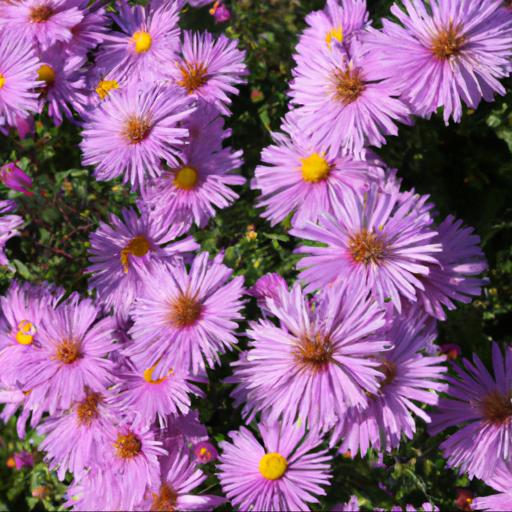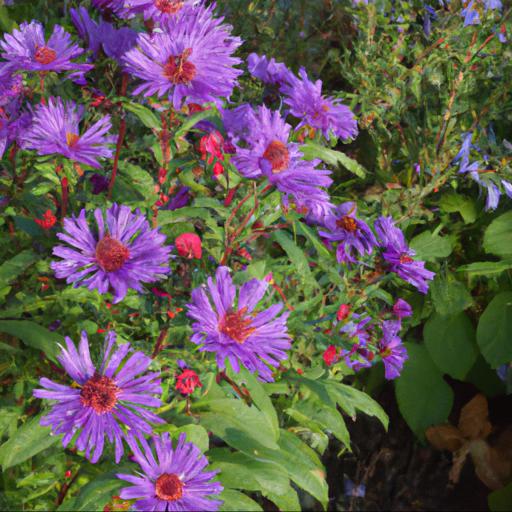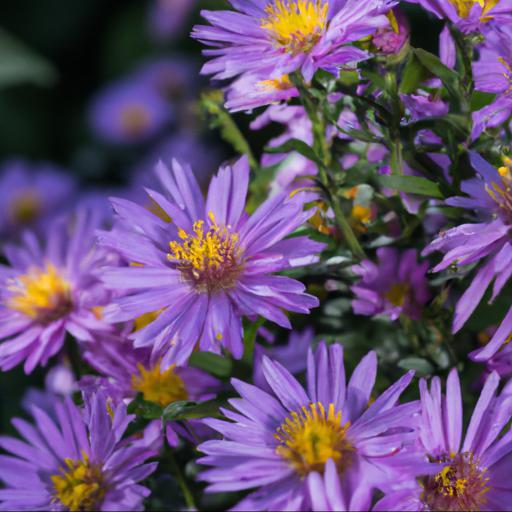Symphyotrichum novi-belgii royal ruby is a beautiful and popular perennial flower known for its deep purple-red color and its ability to attract pollinators. This stunning flower is native to North America, and can be found in gardens and meadows throughout the continent.
It is a hardy plant, able to tolerate a variety of conditions, and is easy to grow and maintain. With its long-lasting blooms, it is a great choice for adding color and beauty to any garden. Its vibrant colors and long-lasting blooms make it a favorite among gardeners and flower lovers alike.
Benefits of growing symphyotrichum novi-belgii royal ruby

When it comes to adding a pop of colour and texture to your garden, Symphyotrichum novi-belgii ‘Royal Ruby’, otherwise known as a Michaelmas Daisy, is an excellent choice. This hardy perennial is a clump-forming and easy-to-grow variety that adds beauty and interest to any garden space.
Not only is it visually appealing, but it also boasts a number of other benefits. This variety of Aster is an excellent choice for the busy gardener who does not have the time to tend to plants on a regular basis, as it is low maintenance and great for wildlife due to its attractive flowers. Its flowers bloom from late summer through autumn, providing your garden with a spectacular display of colour.
Not only that, but its flowers also attract a variety of pollinators, including bees, butterflies, and hummingbirds. When it comes to soil conditions, Symphyotrichum novi-belgii Royal Ruby is very adaptable and can thrive in a variety of soil types, including acidic, neutral, and even heavy clay soil. It also prefers full sun to partial shade, meaning that it can do well in a number of settings.
Its height can range up to four feet, depending on how much space it is given to grow. Overall, Symphyotrichum novi-belgii ‘Royal Ruby’ is a great choice for gardeners looking to add a touch of colour and texture to their outdoor spaces.
Its low-maintenance requirements make it a great option for busy people, and its attractive flowers attract a variety of interesting pollinators. Its ability to thrive in a variety of soil conditions makes it great for those who want to add texture and colour to their gardens.
Tips for planting and caring for symphyotrichum novi-belgii royal ruby

. If you’re looking for an easy care plant that packs a lot of punch, look no further than Symphyotrichum novi-belgii royal ruby (aster royal ruby). With its showy bright purple flowers, this aster is the perfect pop of color in any garden.
One of the best aspects of aster royal ruby is its low maintenance needs. When planting, be sure to choose a location that gets at least 6 hours of full sun and plant it in rich soil with good drainage.
To encourage a larger, fuller plant, deadhead when blooms begin to fade. Aster royal ruby is susceptible to powdery mildew and should be given plenty of space to ensure air circulation.
If you’re looking for a bit more of a challenge, you could consider pinching back some of the stems in the springtime. This will both promote a bushier growth habit and provide you with more flowers. Take care not to pinch too much, however; make sure that the tips of the stems are still visible.
Overall, aster royal ruby is an excellent choice for any level of gardener, ranging from the novice to the more experienced. Once established, it will reward you with eye-catching blooms that will last from summer until the first heavy frosts of autumn. With a bit of patience and some loving care, this plant is sure to bring beauty and color to your garden for many seasons to come.
Common problems with symphyotrichum novi-belgii royal ruby

Symphyotrichum novi-belgii Royal Ruby is a stunning asters produce a froth of blooms in deep shades of red. This hardy perennial is capable of withstanding a variety of climates and is perfect for both beginner and experienced gardeners alike. Unfortunately, even with the best care, Royal Ruby Asters can susceptible to some common issues.
The most common problem with Royal Rubbies is leaf spots. These spots can range from very small to large and can be caused by a variety of environmental conditions such as cool and wet weather, not enough sunlight and too much fertilizer.
If your plants exhibit leaf spots, it is important to take corrective action in order to keep the plants healthy. Reduce the amount of water and ensure the plant receives at least 6 hours of direct sunlight each day; you may also consider using a fertilizer with a lower nitrogen content. Another potential problem is powdery mildew.
This is caused by excessive moisture on the leaves and can severely inhibit growth, as well as leave an unsightly white coating on the stems and leaves. In order to prevent this, keep an eye on the weather and try not to water your Royal Ruby Asters too often.
Move the plant to an area of the garden that receives more air circulation or ideally, a sunny spot in the border. Taking preventative measures such as these will help to ensure your Royal Ruby Asters stay healthy and vibrant. If you experience any other problems or have questions, contact your local garden center or a UK garden expert for advice.
With the right knowledge and care, your Royal Rubbies can be a beautiful addition to your garden for many years to come.
Conclusion
The Symphyotrichum novi-belgii royal ruby is an eye-catching, long-blooming perennial flower that provides an array of vibrant colors to the garden. It is a great addition to any garden, providing a profusion of deep purple-red blooms from late summer through autumn.
The plant is low maintenance and is a great source of nectar for pollinators. Its easy to grow and is sure to add a touch of beauty to any outdoor space.
FAQ
What is the scientific name of the Symphyotrichum novi-belgii Royal Ruby?
The scientific name of Symphyotrichum novi-belgii Royal Ruby is Aster novi-belgii ‘Royal Ruby’.
What are the characteristics of the Symphyotrichum novi-belgii Royal Ruby?
The Symphyotrichum novi-belgii Royal Ruby is a perennial flower with deep purple-red flowers and dark green foliage. It is a hardy plant that is tolerant of a wide range of soil types and can tolerate drought. It blooms in late summer and fall and attracts butterflies and other pollinators. It is easy to grow and requires minimal maintenance.
Where is the Symphyotrichum novi-belgii Royal Ruby native to?
Symphyotrichum novi-belgii Royal Ruby is native to North America, primarily in the eastern United States and Canada.
How does the Symphyotrichum novi-belgii Royal Ruby reproduce?
Symphyotrichum novi-belgii Royal Ruby reproduces by producing seeds that are spread by wind and water.
What type of soil does the Symphyotrichum novi-belgii Royal Ruby prefer?
Symphyotrichum novi-belgii Royal Ruby prefers moist, well-drained soil.
How can the Symphyotrichum novi-belgii Royal Ruby be propagated?
The Symphyotrichum novi-belgii Royal Ruby can be propagated by seed, division, or cuttings.

